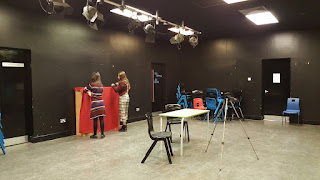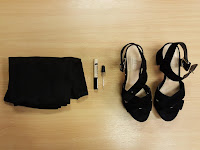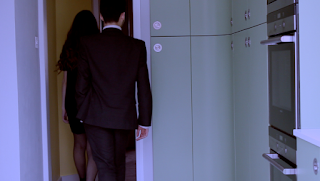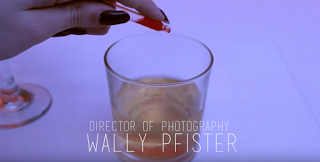Looking back at your preliminary task, what do
you feel you have learned in the progression of it to the full product?

Looking
back on the process to the final product that we have created. I feel as though
I have learned a lot of technical skills but also I have gained new attributes.
My role within the group was Mise-en-scene. Therefore, I had to organize the shoots beforehand in terms of props,
costume, location and lighting. It was difficult to find a location in close
range that everyone had access to, that also suited the genre and
storyline that we were trying to get across. This resulted in certain
scenes within the title sequence having to be re- shot multiple times in order
to be successful with the location. Since I was in charge of Mise-en-Scene it
was really important to me that the location that we used reflected the narrative
of the film and was successful in creating the impression on the audience that
we had desired. This is where I learned the importance of critical feedback
because other people could provide a different perspective to view the sequence.
Therefore, this was a good way to show whether or not they understood the Title
sequence and the genre.

The costume and make up was well considered when making the
sequence. Initially we had discussed having the main protagonist wear a dark
purple dress because purple was a colour that we wanted to associate with her.
However, I thought purple wouldn’t showcase the sophistication that we wanted the
character to have. Therefore, we opted to have the character wearing a black
dress instead. At this point we hadn’t decided on cast. However, we all knew
that we wanted the character to have loose curls and wear dark red lipstick
because the loose curls indicate that she takes care in her appearance, since
curling hair is quite time consuming, and the red lipstick will connote her
promiscuity and danger. The costume was regarded a lot more in our Title
sequence then it was in the continuity sequence. I hadn’t even considered how the characters
should be dressed in the first sequence we shot. Therefore, I learned to be
more conscientious with all the aspects of Mise-en-Scene. I realized how vital
costume was a part of this and how costume can affect how an audience perceives
a character.

In the continuity sequence, we didn’t have access to studio
equipment such as lighting. Therefore, we used the torches on our phones to
light the dark room, that we were filming in. This proved extremely un-successful
because the shots came out very grainy and visually unpleasing. However, I learned
from this and in all the shoots where artificial lighting was needed, the two light boxes
were used either side of the camera to create even lighting. The first shoot
that we did was using the white screen, we had light boxes along with a tri-pod
and a steady cam. It was hard to manoeuvre the light box’s in the position that
we needed. However, in the footage that we captured from that shot, the light
was really flattering and highlighted the white background. This contrasted
well against the black dress and black fishnets. The lighting. However,
was difficult to control in settings where we couldn’t use the light box’s. This
proved difficult to the point that we changed the location of one of the scenes
three times to make sure that the lighting was perfected. This emphasises how
much we had adapted since the Continuity sequence because we were all willing
to be flexible with our ideas in order to improve the lighting within a shot.

Even though I had the role of Mise-en-Scene. During three of
the shoots, the cinematographer within our group was un-able to be present.
Therefore, I was tasked with working with the DSLR’s and modifying the exposure
and lighting settings in order to provide a clean, crisp shot. The focus of the
camera was an issue because it wouldn’t focus if it was too close to an object.
Therefore, for certain shots where we had planned to do extreme close ups, we
had to settle for medium shots. This was frustrating at points
because it interfered with the way we wanted the title sequence structured. For
example, we had desired an extreme close up on the scene where the drink is
spiked. Despite this, we learned to adapt the shots in order to exclude
the close ups. It did however mean that the positioning of the characters
and the props became more significant to direct the audience gaze to the most significant
section in the frame. Although, throughout our shoots positioning was something
that was considerably successful. We were all aware that Typography would need
to be edited in certain shots. Therefore, I made sure that when shooting that
the positioning of items or myself (when I was playing the protagonist) would
work alongside the text that would later be included.
To conclude throughout this task, I feel I have learned to become
more efficient with my time and more flexible to come up with creative
solutions of how solve an issue within production. The problems that we faced
within the continuity sequence were easily learned from and resolved. The
different elements of the Mise-en-scene were consistently considered when
planning or completing a shoot, to the point that it became second nature. As
well as this, I became more confident when using new equipment and taught
myself how to adjust the
settings on a DSLR.

